The administrators can manage the inbound orders under the Inbound orders tab or through the Serialized Logistics for Agro API. The operators can prepare and receive the goods by executing the inbound orders.
The inbound orders can be one of the following types:
- Internal orders (STOs)
- External orders (POs)
- Returns
List of Procedures
- Creating an Inbound Order
- Searching for and Viewing an Inbound Order
- Updating an Inbound Order
- Deleting an Inbound Order
Creating an Inbound Order
Procedure
1. In the Serialized Logistics for Agro application, click the Inbound orders tab. The application displays the list of inbound orders and the Create new inbound order form.
Note: When viewing the details of an order, you can open the Create new inbound order form by clicking Add new +.
Example:

2. Fill in the form as described in the table below. The required fields are marked with an asterisk (*) in the form.
| Field/Function | Action |
|---|---|
| Order ID | Enter the order ID. Free-form text field. |
| Order type | Select the order type:
|
| Order expiration date | Enter the order expiration date. You can use any date format, for example, YYMMDD or YYYYMMDD. |
| Warehouse | Select the warehouse where the order must be executed. |
| Supplier tag | Enter the supplier tag. When you send requests through API, you identify the supplier by using this tag. Connect multiple words with a hyphen (-) or underscore (_), for example, "demo-supplier-online-help". |
3. Click Add line items to your order to be able to create. The application displays the Add line item dialog with an empty form.
Note: As an alternative to open the Add line item dialog, select the Line items tab and click Add Line Item.
Example:
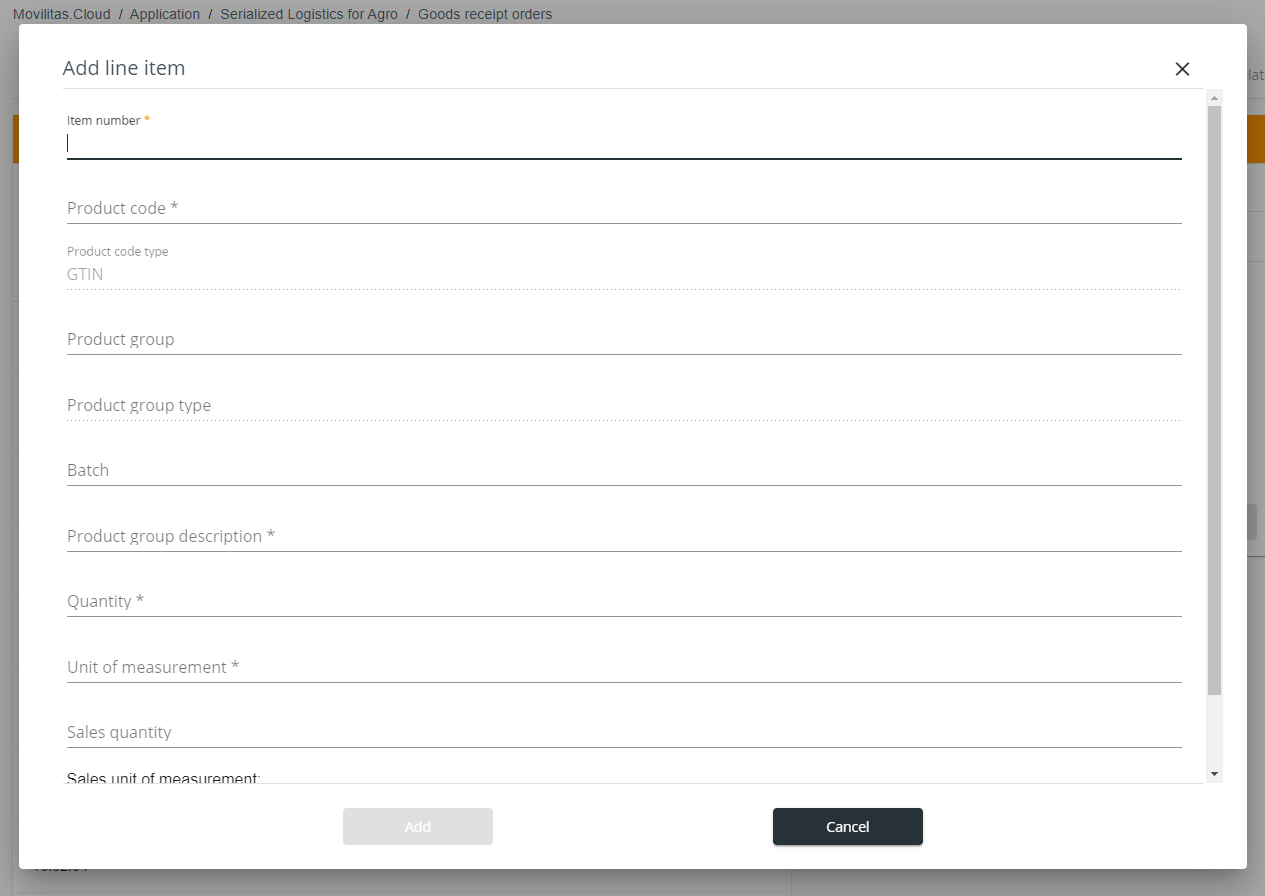
4. Fill in the form as described in the table below. The required fields are marked with an asterisk (*) in the form.
| Field/Function | Action |
|---|---|
| Item number | Enter the line item number. |
| Product code | Enter the product code. You can only add a GTIN. |
| Product code type | Fix, read-only value (GTIN). |
| Product group | Enter the product group code. |
| Product group type | Enter the product group type. |
| Batch | Enter the batch ID. |
| Product group description | Enter the product group description. Free-form text field. |
| Quantity | Enter the quantity of the line item. |
| Unit of measurement | Enter the unit of measurement for the quantity. Free-form text field. For example, "Kg" or "Liter". |
| Sales quantity | Optionally, enter the sales quantity. If you do not want to specify the sales quantity, leave the field blank. |
| Sales unit of measurement | Optionally, select the sales unit of measurement related to the sales quantity.
|
5. Click Add. The line item is added to the inbound order.
6. (Optional) Continue adding further line items as needed.
You can add multiple line items that have different or the same product data, there is no restriction. For example:
- You have two line items with the same product code and batch but with different sales parameters.
- You have line items with completely different product codes, batches, and other data.
7. After you have added all the line items, click Save. The inbound order is created and is added to the list.
Next Steps
The operators can execute the inbound order in the warehouse.
Back to the list of procedures
Searching for and Viewing an Inbound Order
Procedure
1. In the Serialized Logistics for Agro application, select the Inbound orders tab. The application displays the list of inbound orders.
2. Enter the order ID in the search field, select the status, and/or select the order type.
- The list of the orders is filtered based on the search criteria.
- You can reset the filter by clicking Reset filters.
3. Select the order to view its settings (master data).
- If the order can be updated, the application displays the Update inbound order panel with the Order settings tab.
- If the order cannot be updated, the application displays the Inbound order info panel with the Order settings tab.
In both cases, the same type of information is displayed, the only difference is the editability of the order depending on the order status and the application settings. For more information, see Updating an Inbound Order.
Note: The application displays a read-only Operator field. The application automatically adds the operator working on the order to this field.
In the following example, we are searching for order "00705672". The order is in In receiving status and the order settings are not editable:
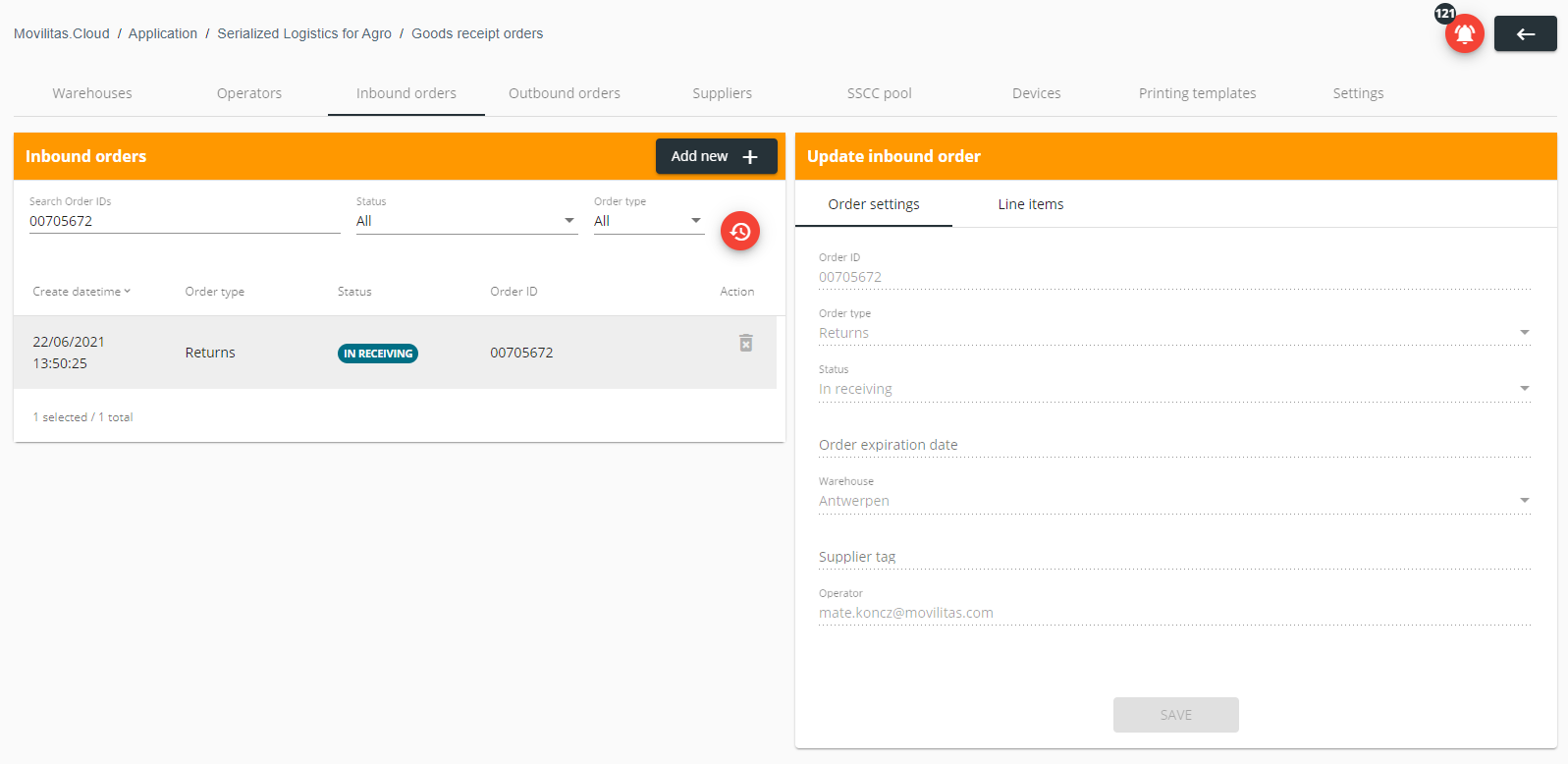
4. Select the Line items tab to view the line items of the inbound order.
Example:

5. Expand a line item by clicking > on the left to view the line item details.
In the following example, we have expanded line item 001 and we are pointing to Scanned items icon:
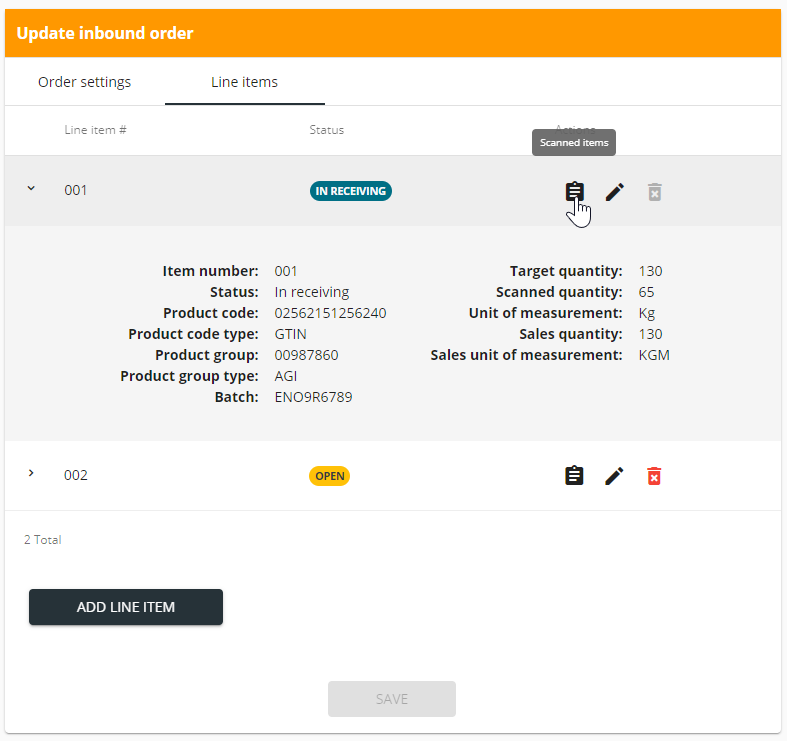
6. Click Scanned items icon to view the items scanned for the line item.
Example:
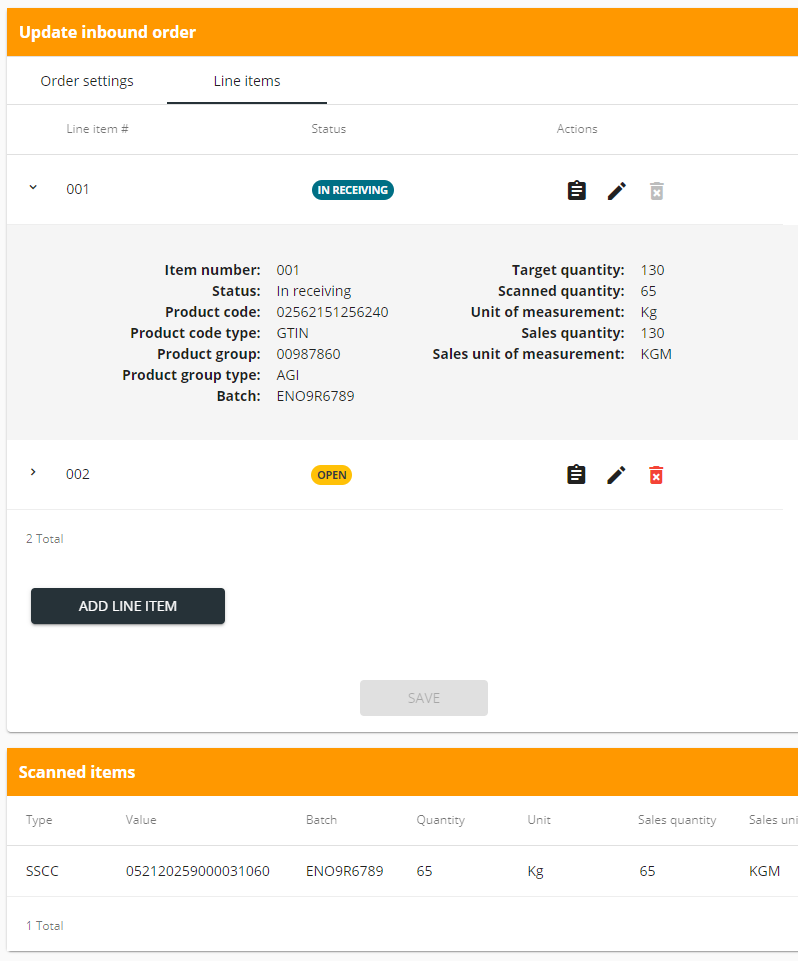
Back to the list of procedures
Updating an Inbound Order
The editability of the order depends on the order status and the application-level settings. The following table summarizes the different scenarios:
| Scenario | Description |
|---|---|
| Order in Open status | You can update the order master data (settings) as well as the line items. You can add new line items, edit the existing line items, and delete line items, as needed. |
| Order is being executed and the update of ongoing orders is activated on the application level (Enable ongoing orders update checkbox is selected under the Settings tab) | You can manage the line items only:
When editing an existing line item, the following is applicable:
|
| Order is being executed and the update of ongoing orders is deactivated on the application level (Enable ongoing orders update checkbox is cleared under the Settings tab) | You cannot update the order, neither the master data (settings) nor the line items. You can only view the order details and the scanned items for each line item. |
Procedure
1. In the Serialized Logistics for Agro application, select the Inbound orders tab. The application displays the list of inbound orders.
2. Find and select the order you want to update.
- If the order can be updated, the application displays the Update inbound order panel with the Order settings tab.
- If the order cannot be updated, the application displays the Inbound order info panel with the Order settings tab.
In both cases, the same type of information is displayed, the only difference is the editability of the order depending on the order status and the application settings.
3. (Optional) For orders in Open status, modify the order settings as needed.
Note: You cannot update the Status and Operator fields as these data are automatically handled by the application. You cannot update the order settings for the ongoing orders.
4. (Optional) Select the Line items tab and manage the line items of the order as needed.
| Operation on Line Item | Description |
|---|---|
| Add | Click Add Line Item, fill in the form, and click Add. You can add multiple line items that have different or the same product data, there is no restriction. For example:
Example: 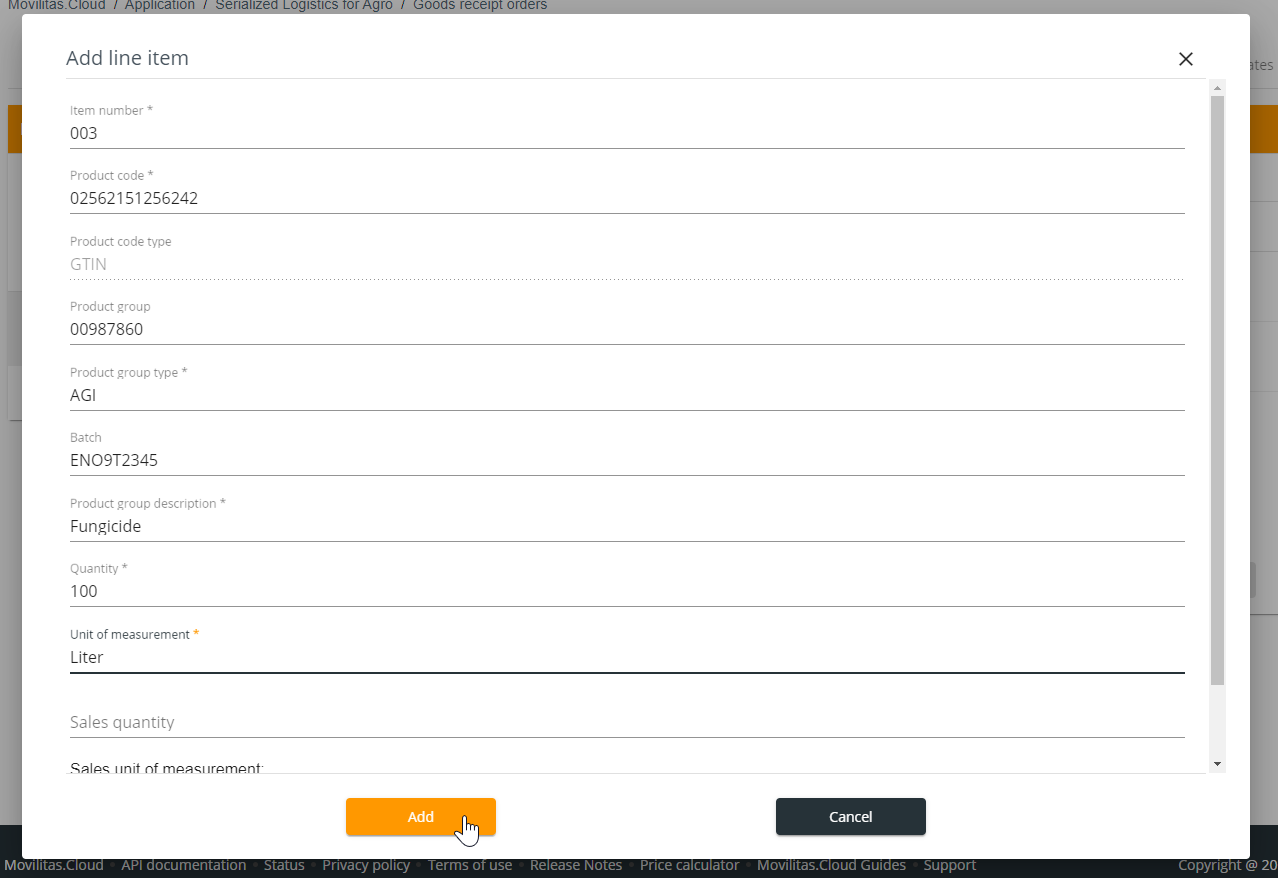 |
| Edit | Click on the edit icon, modify the allowed parameters in the opened form, and click Modify.
In the following example, we can only modify the quantity and sales quantity for the line item as we have scanned items:
|
| Delete | Click the delete icon (only applicable when the icon is active). In the following example, we are removing line item 002, while we also have an unsaved, newly added line item (003):  |
5. Click Save.
Back to the list of procedures
Deleting an Inbound Order
You can delete only the orders that are in Open status.
Procedure
1. In the Serialized Logistics for Agro application, select the Inbound orders tab. The application displays the list of inbound orders.
2. Find the order you want to delete.
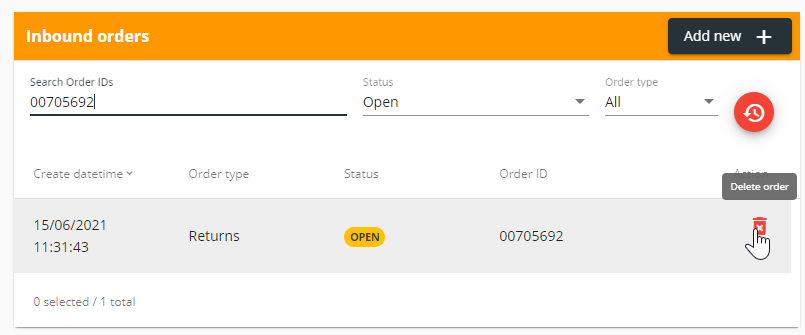
3. Click the delete icon next to the order and confirm the deletion by clicking Yes.
Back to the list of procedures

